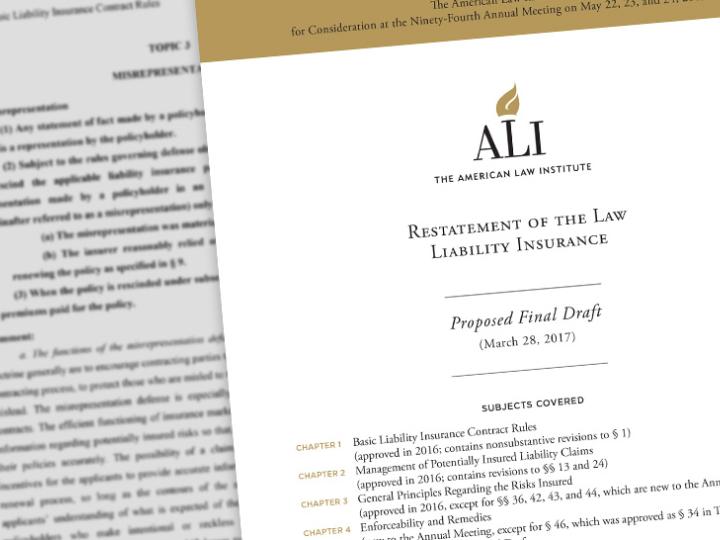In a decision that discussed the issue of rescission of insurance contracts in cases of material misrepresentations in insurance applications by high-risk insureds, the Superior Court of the State of California, County of Los Angeles cited the Proposed Final Draft of Restatement of the Law, Liability Insurance.
Citing the Comments and Reporter’s Notes in Section 7. Misrepresentation, first Comment a w as cited:
a. The functions of the misrepresentation defense. The functions of misrepresentation doctrine generally are to encourage contracting parties to provide accurate information during the contracting process, to protect those who are misled to their detriment, and to penalize those who mislead. The misrepresentation defense is especially important in the context of insurance contracts. The efficient functioning of insurance markets requires that insurers receive accurate information regarding potentially insured risks so that, among other reasons, insurers can price their policies accurately. The possibility of a claim denial or policy rescission can create incentives for the applicants to provide accurate information during the policy application and renewal process, so long as the contours of the misrepresentation rules match insurance applicants’ understanding of what is expected of them. In addition, as a matter of fairness, policyholders who make intentional or reckless misrepresentations on their insurance applications should not be permitted to shift losses to insurance companies that have relied in good faith on the policyholders’ answers. Such losses ultimately are shifted to other policyholders who have behaved in good faith in the application and renewal processes. (emphasis added).
The court went on to include portions of the Reporter’s Note, adding “The Reporters’ Note further illuminate the importance of accurate application information so that the underwriting process is fair to all involved in the purchase and sale of insurance for presumptively comparable risks:”
The misrepresentation defense helps to combat the problem of adverse selection. Adverse selection arises when insurance applicants have better information about the risks that they present than the insurer has. In such situations of asymmetric information, relatively high-risk parties will be disproportionately likely to purchase insurance because insurance companies are unable to identify, and charge different premiums to, applicants within the insurance pool who present different levels of risk. The result is that premiums are driven up for everyone in the pool, inducing relatively low-risk insureds left in the pool to drop out. This process continues until the insurance pool “unravels” completely or an equilibrium is achieved. “In either case, low-risk parties buy less coverage and high-risk parties buy more coverage than they would if insurers could distinguish the risk posed by different policyholders.” Abraham & Schwarcz, Insurance Law and Regulation, at 7. Insurers’ inability to identify accurately the risks posed by individual insureds thus produces both inefficiency and unfairness. The inefficiency results from the fact that insureds who pay premiums that do not reflect accurate risk estimates will tend to make decisions that diverge from the social optimum—for example, engaging in too much of the activity being insured (if their premium is set too low) or too little (if their premium is too high). The unfairness results from the fact that, within a given risk pool, low-risk insureds subsidize high-risk insureds. Such cross-subsidization is inevitable, given the technological limits of risk segregation. Moreover, it is not considered unfair when the insureds are unaware ex ante whether they present a below- or above-average risk; whether one ends up (ex post) turning out to be a high-risk or a low-risk insured is part of the uncertainty that is shifted from the insureds individually to the pool collectively through the insurance product. The unfairness mainly arises when a subset of insureds are aware ex ante that they are relatively high-risk and choose fraudulently to understate those risks to take advantage of the lower-risk insureds. (emphasis added).
